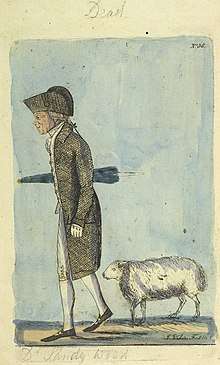Alexander Wood (surgeon)
Alexander Wood (14 June 1725– 12 May 1807) was a Scottish surgeon, who was active in the convivial clubs which flourished in Enlightenment Edinburgh and was the founder of two of these. Owing to his lean, lanky physique he was better known to his contemporaries and to posterity as "Lang Sandy" Wood. His treatment of and friendship with the poet Robert Burns contributed to the local celebrity status which he attained.
_Wood_with_umbrella_caricatured_by_John_Kay.jpg)
_Wood_caricatured_by_John_Kay.jpg)
Alexander Wood | |
|---|---|
 Dr Sandy Wood and his pet sheep | |
| Born | 14 June 1725 |
| Died | 12 May 1807 (aged 81) Edinburgh, Scotland |
| Nationality | Scottish |
| Education | University of Edinburgh |
| Occupation | surgeon |
| Known for | friendship with Robert Burns founder of the Aesculapian Club and the Harveian Society of Edinburgh first man in Edinburgh to use an umbrella excentricities including owning a raven and a sheep as pets |
| Medical career | |
| Sub-specialties | surgery |
Early life, education
Wood was born at Restalrig on 14 June 1725, the son of Thomas Wood (1702-1798), a farmer, and his wife Janet Lamb.[1][2] He studied medicine at the University of Edinburgh and after graduating took up practice in Musselburgh.
Medical practice
He became a Freeman of the Incorporation of Surgeons of Edinburgh in 1756,[3] and was appointed to the staff of the new Royal Infirmary of Edinburgh. Elected Deacon (President) of the Incorporation of Surgeons in 1762, he held office for two years.[4] He was in surgical practice with the surgeons John Rattray (1707 – 1771) and Charles Congleton.[5] Two of his pupils held him in high regard; surgeon John Bell (1763 – 1820) dedicated his book Anatomy of the Human Body to Wood to him[6] and Sir Alexander Morison (1779–1866), the pioneer of psychiatric medicine, composed a poem in his honour.
As far as is known, he made no known contributions to the advancement of surgical knowledge.
Personal and social life
Wood married Veronica Chalmers and one of their sons, Sir Alexander Wood, married the eldest daughter of William Forbes of Pitsligo, and later became Chief Secretary for the government of Malta.[5] His brother Thomas Wood (1747-1821) and son George Wood were also Edinburgh surgeons. George's son was Alexander Wood, Lord Wood.[2] His grand-nephew Dr Alexander Wood (1817–1884) introduced hypodermic medication into medical practice.
Wood became a well known and popular figure in Edinburgh with a reputation for a warm and generous nature. He was a member of many dining clubs and convivial societies which characterised the Scottish Enlightenment in Edinburgh. He founded two such clubs which continue are still active, the Aesculapian Club (1773)[7] and the Harveian Society (1778).[8]
He was known for his personal idiosyncrasies and was often accompanied around Edinburgh by two pets, a tame sheep and a raven which perched on his shoulder. He was said to be the first person in Edinburgh to own and use an umbrella which he did from 1780.[9]
In June 1792 he infamously narrowly escaped death during the Dundas Riots when being mistaken for the Lord Provost, Sir James Stirling, and threatened to throw him off North Bridge.[10]
Lord Byron included a couplet about him in the 5th canto of his poem Childe Harold's Pilgrimage in which he describes contemporary Edinburgh and some of its characters. It was published in Blackwood's Magazine in May 1818:[1]
"Oh! for an hour of him who knew no feud, The octogenarian chief, the kind old Sandy Wood!"
Friendship with Robert Burns
After he treated a leg injury sustained by the poet Robert Burns on his visit to Edinburgh in 1787, Burns's close friend Agnes Maclehose (Clarinda), herself a surgeon's daughter, wrote to Burns, "I am glad to hear Mr Wood attends you. He is a good soul and a safe surgeon. Do as he bids and I trust your leg will soon be quite well".[11] Wood and Burns became friends with Burns referring to "My very worthy respected friend, Mr Alexander Wood" and to "one of the noblest men in God’s world - Alexander Wood, Surgeon".[12]
Wood died on 12 May 1807, in Edinburgh. He was 82 years old.[1]
References
- Matthew, H. C. G.; Harrison, B., eds. (23 September 2004), "The Oxford Dictionary of National Biography", The Oxford Dictionary of National Biography, Oxford University Press, doi:10.1093/ref:odnb/29861
- https://library.rcsed.ac.uk/media/1326/gd-100_12-genealogical-notes-of-the-wood-family_digital-copy.pdf
- RCSEd list of Fellows. Royal College of Surgeons of Edinburgh
- Macintyre IMC and MacLaren IF (eds) Surgeons Lives. Edinburgh.Royal College of Surgeons of Edinburgh. (2005) ISBN 0950362093
- Lee, Sidney, ed. (1900). . Dictionary of National Biography. 62. London: Smith, Elder & Co.
- Bell, John; Bell, Sir Charles (1802). The Anatomy of the Human Body . T.N. Longman and O. Rees.
- Guthrie, Douglas. The Aesculapian Club of Edinburgh. University of Edinburgh.
- Chalmers, John (ed.), Andrew Duncan Senior: Physician of the Enlightenment. Edinburgh: National Museums Scotland, (2010) ISBN 978-1-905267-30-9
- Kay, John; Paton, Hugh. Kay’s Portraits : A series of original portraits and caricature etchings by the late John Kay, with biographical sketches and illustrative Anecdotes. Edinburgh; Hugh Paton: 1842. ISBN 9781841586571 http://edinburghbookshelf.org.uk/volume8/page237.html
- Grants's Old and New Edinburgh
- Burns, Robert; M'Lehose, Agnes Craig; Burr, Amelia Josephine (1917). Sylvander and Clarinda : the love letters of Robert Burns and Agnes M'Lehose. Pratt - University of Toronto. New York : George H. Doran.
- Burns, Robert (1855). The Complete Works of Robert Burns: Containing his Poems, Songs, and Correspondence. New York: J C Derby. p. 141.
Further reading
Carlyle, E.I. Alexander Wood (1725-1807).Dictionary of National Biography, 1885-1900, Volume 62 http://en.wikisource.org/wiki/Wood,_Alexander_%281725-1807%29_%28DNB00%29
Kay, John; Paton, Hugh. Kay’s Portraits : A series of original portraits and caricature etchings by the late John Kay, with biographical sketches and illustrative Anecdotes. Edinburgh; Hugh Paton: 1842. ISBN 9781841586571 http://edinburghbookshelf.org.uk/volume8/page237.html